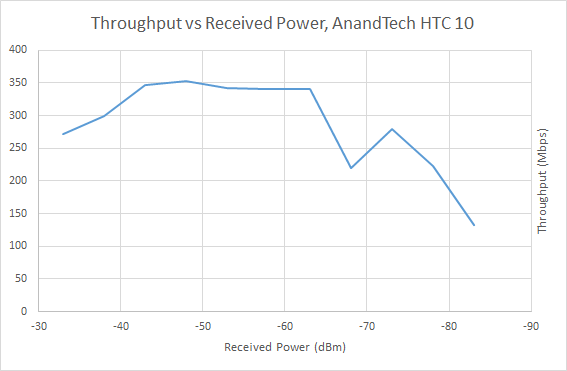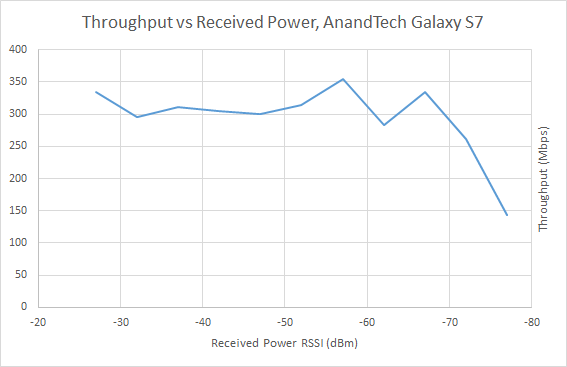The HTC 10 Review
by Joshua Ho on September 19, 2016 8:00 AM ESTWiFi Performance with Ixia IoT
As previously discussed, RF testing has always been a major unknown to some extent because environmental factors make it extremely difficult to tell exactly what is going on with the system. I don’t think it really needs to be said but previous reviews and any controversy regarding the quality of RF has always lead to a ring of confusion and back and forth with no clear-cut answers, at least in the public domain. The Transformer Prime and Pixel C reception issues have all been cases where I’ve seen a lot of confusion over whether a problem really existed in the hardware, software, or with the end user.
Most people really don’t have any understanding of how wireless transmission works, probably because it’s not really something you can see. As far as I know, no one is capable of seeing radio waves, even at high frequencies like 60 GHz. Of course, the problem is that for quite some time our testing was also not really ideal for seeing the quality of an RF implementation. While iPerf does provide some useful data, free space testing means that we’re dealing with channel conditions that inherently cannot be controlled. As a result, the only sensible test we could do with iPerf was focus on maximum throughput in the best conditions we could provide. The only thing that this can highlight is the upper bound of efficiency for WiFi due to the carrier sense multiple access scheme in most cases, and rarely detects a whole class of problems that affect user experience on WiFi.
In order to test these things we’ve moved to using a proper testing system that is actually used by at least a few OEMs today, namely Ixia IoT. While we discussed the possibilities for testing, at this time due to the RF isolation chamber used we are limited to AP simulation only, so we can’t properly simulate clients in the channel without restricting ourselves to a single spatial stream for both the AP and client. This wouldn’t be a very useful test if set up in this manner as most devices today that we’re testing have support for two spatial streams, and many routers have three or even four spatial streams at this point.
The first set of results we can talk about that will be of interest is rate vs range. This is a fairly simple test at a conceptual level, as it simply tries to see how well a device can maintain its performance in the face of reducing signal to noise ratio for a given modulation and coding scheme. This is a good high level test of how well a device can maintain a connection as reception degrades. In this test the HTC 10 had an initial RSSI of -28 dBm while the GS7 was at -21 dBm and the iPhone 6s at -22 dBm, which allows us to calculate the path loss and determine the RSSI as a function of the transmit power.
The results of this test are interesting to say the least. Off the bat, every device had different RSSIs measured, so this meant that everything had different levels of path loss. The HTC 10 seemed to have the most path loss, while the Galaxy S7 and iPhone 6s were functionally identical. However it looks like RSSI is really an insufficient metric here because while the iPhone 6s was able to reach maximum throughput using NSS 2 MCS 8, the HTC 10 and Galaxy S7 did its best at NSS 2 MCS 4 or 5. I suspect this may be just due to placement as device positioning strongly affects MIMO as receive-side spatial correlation reduces the gains that MIMO can provide. Regardless, the HTC 10 somehow manages to beat the Galaxy S7 through much of the curve, but for some reason suffers from a reduction in throughput at higher transmit power. It's worth mentioning though that this test doesn't allow for testing of antenna gain or similar tests. Given various levels of futzing about with the device positioning in the test chamber I'm fairly confident that the Galaxy S7 is consistently better with regard to path loss, so even if it doesn't perform as well at a given RSSI it tends to have a higher RSSI than the HTC 10 by about 5 dBm which is fairly significant. I'm hoping to get some true antenna efficiency measurements with 3D plots in the near future so we can really give some real data on everything relevant here but for now this test highlights fairly well how WiFi performance varies.
Finally, the other test that we can run at this time is the roaming latency test, which tests how well a device can hop from one access point to another as the received transmit power rises and falls. If you ever rely on WiFi to work as you walk around any building larger than a single apartment unit, you’re going to feel the effects of high roaming latency as VOIP calls or any real-time network application will either experience interruption or drop altogether if roaming is not implemented properly.

Like the Galaxy S7, the HTC 10 really struggles with WiFi roaming as it seems almost universal that Android OEMs aren't really paying attention to anything that we don't test. The HTC 10 tended to not fail handover as often as the Galaxy S7 with only one failure out of 64 trials and fairly consistent latency around 110ms though. This is a bit of a surprise considering that the HTC 10 is generally considered in the broader discourse to have worse WiFi across the board compared to the Galaxy S7. Considering how much smaller HTC is this is really kind of strange to see. Just about anything will outperform the Pixel C though. Either way, HTC still should improve here, especially when considering how most schools and offices need good WiFi to make up for areas with cellular coverage gaps.













183 Comments
View All Comments
Awful - Monday, September 19, 2016 - link
This review is interesting insofar as it gives insight into what we might see coming from HTC in the new Pixel (Nexus) phones on Oct 4...so in some ways the timing isn't so bad. I gave up on 3rd party phones after the nexus 5...Impulses - Thursday, September 22, 2016 - link
Ditto.Fidelator - Monday, September 19, 2016 - link
Fantastic review, the HTC 10 is really as good as I hoped it to be, which is basically the top of the hill, I'm sure a lot of readers would appreciate a new Audio quality section on these reviews, of course, keeping some subjective comments on the speaker quality and listening experience, it's an important piece of what makes a device great.Definitely considering this as my next device
randomguy128 - Monday, September 19, 2016 - link
What do you mean by featured review. Did HTC have to pay you guys to finally do this reviewvision33r - Monday, September 19, 2016 - link
Good phone 8 months ago. HTC failed to deliver a bigger size 10, fewer people in Asia buys phones smaller than 5.5" these days. Every Android OEM in China starts at 5.5" and work their way up to 6"Anakha - Monday, September 19, 2016 - link
Wow... Anandtech beat HTC South Africa. I had a bet with a friend on which would come first, the review on Anandtech or the release of the HTC 10 in South Africa. Sadly, we are still waiting for the 10 in South Africa and it got to the point where I said stuff it and upgraded my contract to the Huawei P9 Plus. I was really looking forward to the 10 but I just could not hold onto the M8 for any longer and needed something better. Hopefully next year HTC can launch on time...Vagabondjonez - Tuesday, September 20, 2016 - link
awesome story manzeeBomb - Monday, September 19, 2016 - link
That distillation starts at the name it seems as rather than the One M10 as you might expect given that the naming scheme for the past few generations has meant that its predecessors are called the One M8 and One M9.Wut
asfletch - Tuesday, September 20, 2016 - link
I would just like to echo comments praising the review and disagreeing with the 'too late' sentiment. The 10 launched here in Australia at ~US$830 and is still around US$750 at major retailers. I wasn't at all sure it was worth so much, so I ended up going with a NOS Note 4 instead for half the price.Now I am armed with the confirmation I need that it's the phone for me (and knowledge that I want a Sharp rather than Tianma display version), I am happy to wait until it drops closer to $400 and my Samsung wears out. I like reading on 5.7" but I'll be happy to go back to 5.2 for my next phone for easier one-handed use.
PS if LG made a V20 mini I'd be all over it (no, the G5 is not that phone).
jtang97 - Tuesday, September 20, 2016 - link
Only a small paragraph about the audio quality of the HTC 10? It always amazes me that a lot of sites when reviewing mobile PHONES do not talk about the audio quality. Sure, it might not be used for conversing with others so much anymore but it's still important.Also, I don't know what version you are using, but when I change the volume, the audio slider disappears after a few seconds. It has NEVER remained on the screen like you claim it does. Tapping on the screen after you moved the slider only makes the slider disappear faster.